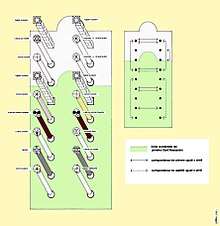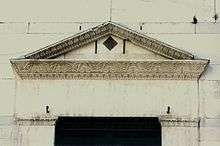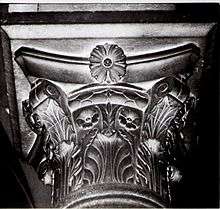Sant'Alessandro, Lucca
Sant’Alessandro Maggiore is a Romanesque-style, Roman Catholic parish church in Lucca, region of Tuscany, Italy.
| Church of Saint Alexander Sant'Alessandro (in Italian) | |
|---|---|
Façade of the church | |
| Religion | |
| Affiliation | Roman Catholic |
| Province | Archdiose of Lucca |
| Rite | Latin Rite |
| Status | Parish church |
| Location | |
| Location | Lucca, Italy |
| Geographic coordinates | 43°50′31.97″N 10°30′5.39″E |
| Architecture | |
| Type | Church |
| Style | Romanesque |
| Groundbreaking | 9th century |
| Website | |
| www | |
History

First mentioned in a document dated 893, the layout is that of a Romanesque basilica, with little decoration, giving the facade a sober classicism.[1][2]
The present building, however, contains the structures of an older church,[3] whose date of construction is still a matter of controversy, and whose features are surprisingly close to those of Roman architecture:[4] This church is a rare and good preserved example of medieval classicism, an evidence of survival in Italy, during the Dark Ages, of Roman architectural tradition. The small building can be compared only with monuments as the Baptistry in Florence or the Basilica of San Salvatore in Spoleto.
Description

The building is entirely dressed in perfectly smooth white limestone slabs according to a layout of alternating high and low bands, in a system which is evocative of the opus quadratum pseudoisodomum of the buildings of antiquity. The apertures framing sculpted details — within this rigorously geometric design — are also directly derived from the Ancient Roman architecture. This interpenetration of a static, geometric system can also be seen in the arches within the church, where the white and coloured stone is arranged symmetrically throughout, as is found in sixth and seventh century buildings such as the Mausoleum of Theodoric in Ravenna and the Dome of the Rock in Jerusalem (or in peristyle of Diocletian's Palace in Split, ca. 300 AD). As is also to be seen in the early Christian basilicas in Rome, the interior of the church is divided into functional areas and crossed by a liturgical route which is clearly indicated, down to the smallest detail, by variations in the colour of the marble and by the different types of capital in pairs which match across the nave. There are further reminders in the taste for varietas which (in the same strictly symmetrical context) informs all the sculpted ornamentation, whose careful variations have parallels in the Basilica of San Salvatore in Spoleto and in the capitals of the Temple of Saturn in Rome, rebuilt in the fourth century A.D.

Finally, the character of the sculpture is unusual. On the one hand, the vegetal elements -geometric, flat and with finely incised details — are set out according to a predominantly paratactic/symmetrical system (such elements are typical of sculpture of later antiquity), while on the other, the designs which are repeatedly copied (including unusual Corinthian variations and rare motifs of the Augustan Age) are typical of the first and second centuries A.D. While the most recent parts of the building correspond to twelfth century architecture (in particular the work of Biduino and his school), the unusual features of the older Sant’Alessandro make it an isolated example in local medieval architecture.[5][6][7][8]
References
- Ragghianti, Carlo Ludovico (1949). "Architettura lucchese e architettura pisana". Critica d'arte (in Italian). 28.
- Taddei, Carlotta (2005). "Lucca tra XI e XII secolo. Territorio, architetture, città". Quaderni di Storia dell'Arte" (in Italian). 23: 117–156.
- Silva, Romano (1987). La chiesa di Sant'Alessandro Maggiore in Lucca (in Italian).
- Seidel, Max; Silva, Romano, eds. (2001). "La chiesa di Sant'Alessandro tra archeologia e ricerca documentaria". Lucca città d'arte e i suoi archivi. Opere d'arte e testimonianze documentarie dal Medioevo al Novecento (in Italian). pp. 59–96.
- Carrai, Giampaolo (2002). Tradizione tardoantica e derive medievali nella chiesa di Sant'Alessandro a Lucca (in Italian).
- Tigler, Guido (2006). Toscana romanica (in Italian). pp. 245–247.
- Frati, Marco (2014). Architettura romanica a Lucca (XI-XII secolo). Snodi critici e paesaggi storici, in Chiara Bozzoli - Maria Teresa Filieri (a cura di),Scoperta armonia. Arte medievale a Lucca (in Italian). pp. 177–224.
- Carrai, Giampaolo (2017). La chiesa di Sant'Alessandro Maggiore a Lucca : un exemplum di architettura sacra come figura teologica (in Italian).
External links

- "Church Sant'Alessandro". Lands of Lucca and Versilia. (in English)
- Church of Sant'Alessandro Maggiore
- On site investigation techniques for the structural evaluation of historic masonry buildings (1)
- On site investigation techniques for the structural evaluation of historic masonry buildings (2)